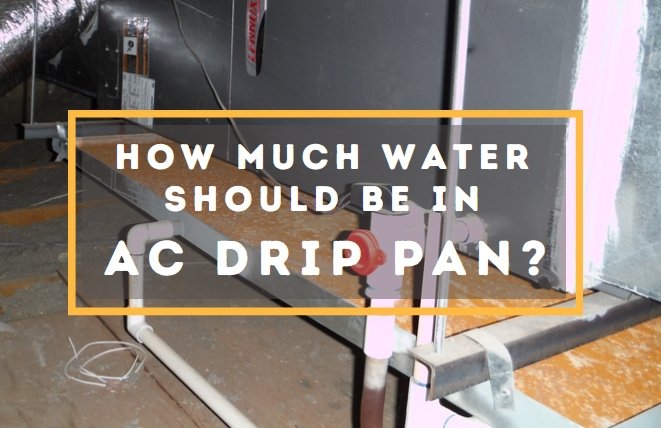Have you ever wondered, “how much water should be in AC drip pan?” The answer is yes, but only to a certain extent. An AC drip pan collects condensation from the unit, but when it overflows or smells odd, it signifies underlying issues. This article analyzes the AC drip pan’s function, normal water levels, potential issues, and maintenance tips.
Understanding the AC Drip Pan
What is an AC Drip Pan?
The AC drip pan is a crucial component in your air conditioning system. It collects the condensation that forms when the AC unit cools the warm, humid air from your home. This condensation drips down into the AC pan, which should ideally drain away without causing any issues.

Normal Water Levels
An air conditioner can produce 5 to 20 gallons of condensate daily, especially on humid days. While it’s normal for the pan to have some water, the level mustn’t surpass the drain line exit. This ensures the water drains properly and prevents overflow.
Identifying Issues with Your AC Drip Pan
Full or Overflowing Drip Pan
Seeing a full or overflowing AC drip pan can be concerning for homeowners. Here are the potential reasons behind this occurrence:
- Clogged Drain Line: The drain line can get clogged with dirt, debris, and mold, hindering the proper water drainage from the pan. This obstruction can result in water buildup, causing it to overflow.
- Dirty Filters: Filters can only allow airflow if they are changed or cleaned regularly. This reduced airflow can cause the evaporator coil to freeze. When this frozen coil eventually melts, it can lead to excessive water in the drip pan, causing it to overflow.
- Damaged Drip Pan: Like all components, the drip pan can suffer wear and tear over time. Cracks or holes in the pan can lead to water leaks, even if the water is within the normal range.
- Low Refrigerant Levels: The refrigerant cools the air in the air conditioning system. If its level is low, often due to leaks or lack of maintenance, the evaporator coil can freeze. Similar to the issue with dirty filters, when this coil melts, it can lead to the drip pan filling up with more water than it can handle.
Read also: What Causes an Air Conditioner to Freeze Up?
Solutions for a Leaking AC Drip Pan
Addressing a leaking AC drip pan is essential for the efficiency of your air conditioner and the overall health of your home.
Clearing the Clogged Drain Line
To address this:
- Ensure the power to the unit is off.
- Locate the drain tube and gently disconnect it from the AC unit.
- Use a wet or dry vacuum to clear out any obstructions.
- Pour a diluted bleach or vinegar solution into the pipe to prevent mold growth.
- Once cleared, reconnect the drain pipe, ensuring it’s securely attached.
Keeping the AC Unit Clean
Dust, dirt, and debris are common culprits behind clogged drain lines. Ensuring the indoor and outdoor units are clean can reduce the chances of these particles entering the system. Regular dusting and cleaning of the units can go a long way in preventing blockages.
Addressing Drip Pan Damage
If you notice water leaking from the pan:
- Inspect it for any visible damage.
- Small gaps can be sealed using industrial-grade adhesive.
- If the damage is extensive, replacing the pan is best.
Monitoring Refrigerant Levels
Low refrigerant levels can cause the evaporator coil to freeze, leading to an overflow when it melts. Regularly check the refrigerant levels and top up if necessary. If you’re consistently running low on refrigerant, there might be a leak in the system that needs addressing.
Maintaining Your AC Drip Pan
Regular Maintenance Tips
- Inspect the Pan: Regularly inspect the drip pan for cracks or holes.
- Clean the Drain Line: Periodically clean the drain line to prevent clogs.
- Check Refrigerant Levels: Ensure the refrigerant levels are adequate to prevent freezing of the evaporator coils.
- Replace Filters: Replace or clean filters regularly to maintain proper airflow.
Professional Inspections
Hiring a professional for regular inspections can help identify and address issues before they become significant problems. Professionals can thoroughly check the entire AC system, including the drip pan, to ensure everything functions correctly.
Conclusion
Understanding how much water should be in an AC drip pan is crucial for maintaining the efficiency and longevity of your air conditioning unit. Regularly inspecting and maintaining your AC drip pan can prevent costly repairs and ensure a comfortable living environment.
Regular maintenance, cleaning, and professional inspections can go a long way in keeping your AC unit in optimal condition, ensuring that your home remains cool and comfortable even on the hottest days.
Read also: My Air Conditioner Leaks Water Outside, How to Deal With This?
This article is crafted by HVAC professionals with years of experience in the field. Our team regularly maintains, repairs, and installs air conditioning systems, providing us with practical insights into common issues like water accumulation in AC drip pans.
We base our information on established practices and guidelines in the HVAC industry. Our expertise is backed by certifications from leading HVAC organizations and a deep understanding of the technical aspects of air conditioning systems.
Detailed Breakdown of Potential Issues and Solutions
| Issue | Cause | Solution |
|---|---|---|
| Full or Overflowing Pan | Clogged drain line, dirty filters, damaged pan, low refrigerant levels | Clear the drain line, replace filters, inspect and repair/replace the pan, monitor and refill refrigerant |
| Clogged Drain Line | Dirt, debris, mold blocking the line | Disconnect and clean the drain line with a vacuum and a bleach/vinegar solution |
| Dirty Filters | Filters clogged with dust and debris | Replace or clean filters regularly to maintain airflow |
| Damaged Drip Pan | Cracks or holes in the pan | Seal small gaps with industrial-grade adhesive or replace the pan if extensively damaged |
| Low Refrigerant Levels | Leaks or inadequate maintenance leading to frozen evaporator coils | Regularly check refrigerant levels, refill as necessary, and address leaks if consistently low |
By following these guidelines and regularly maintaining your AC drip pan, you can ensure the efficiency and longevity of your air conditioning unit. Remember, understanding the water AC drip pan and taking proactive measures can save you from costly repairs and discomfort during hot days.


